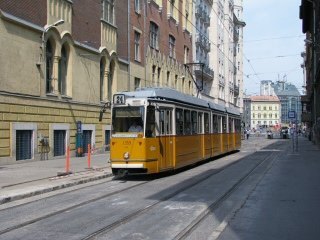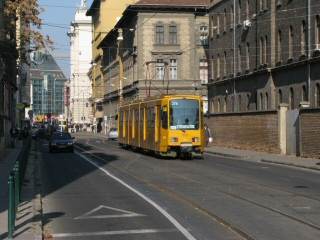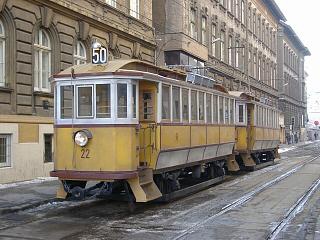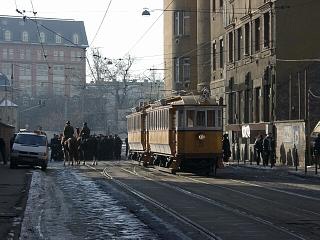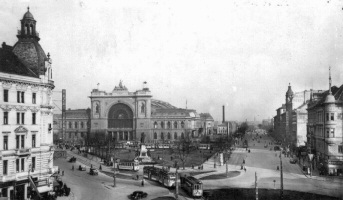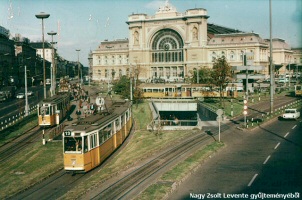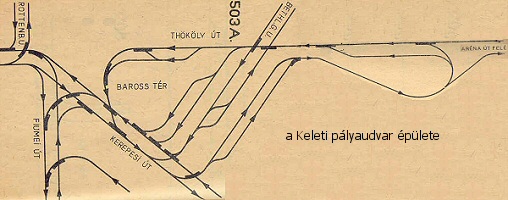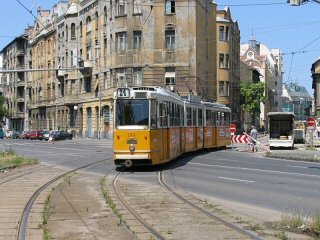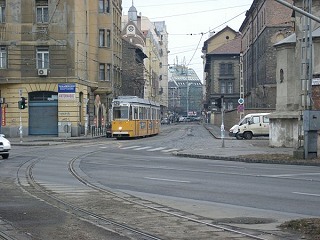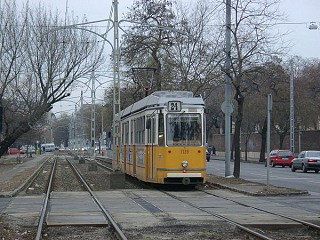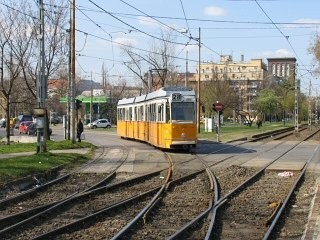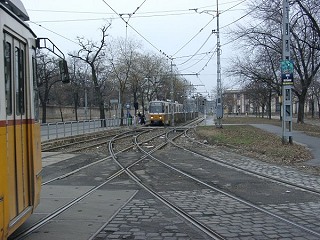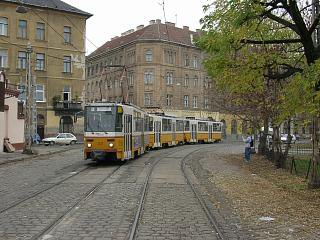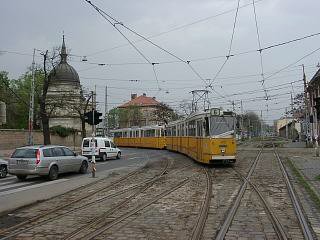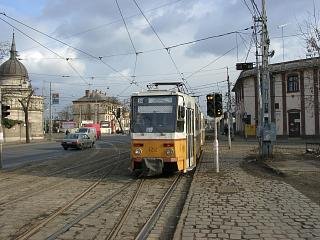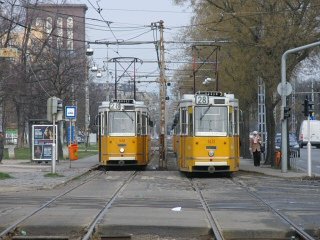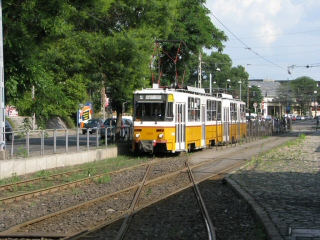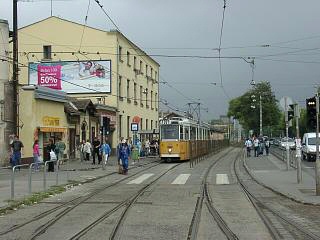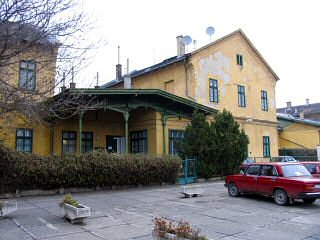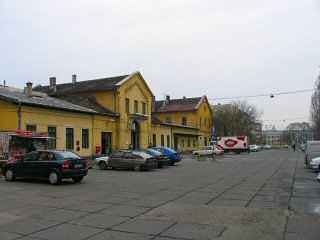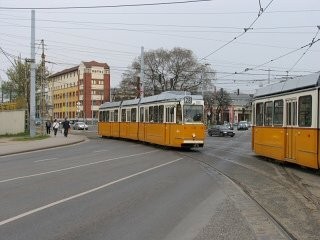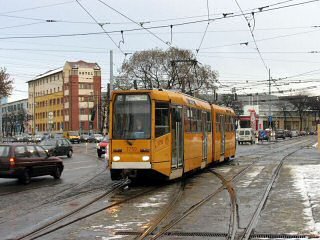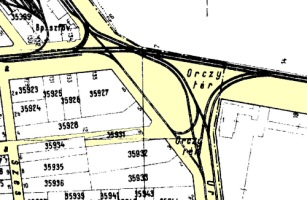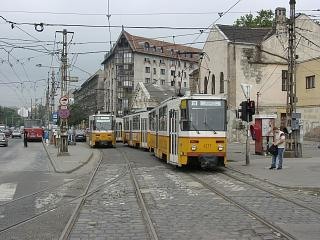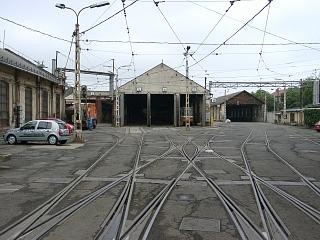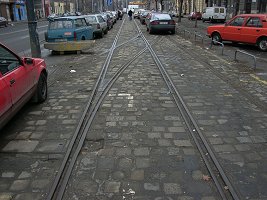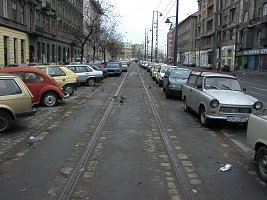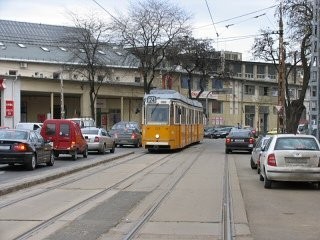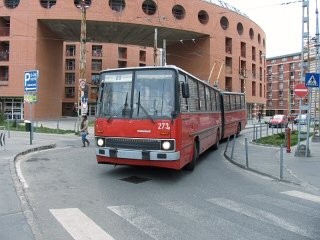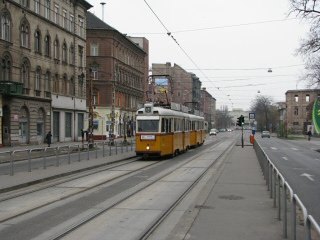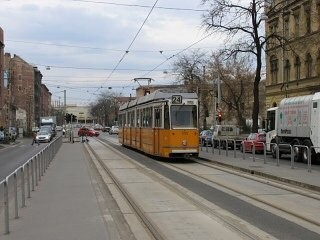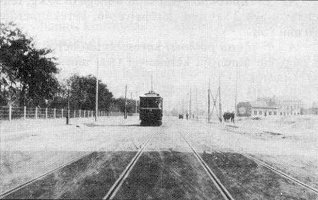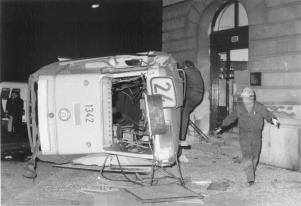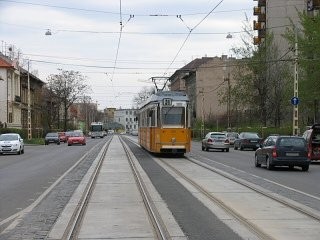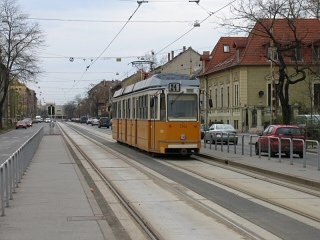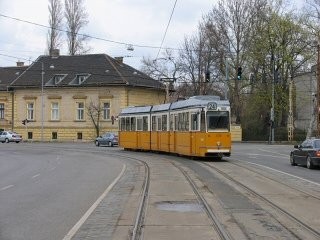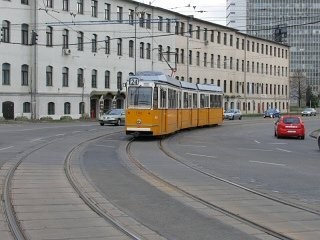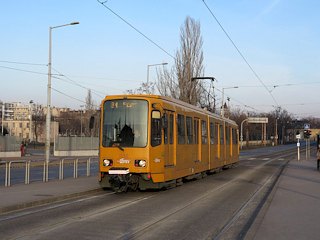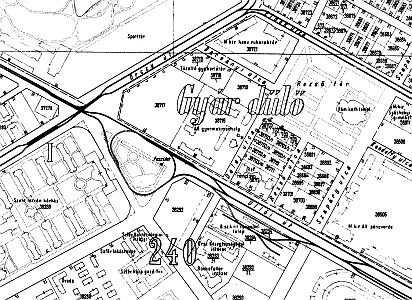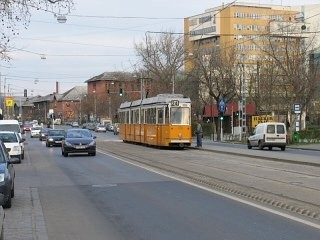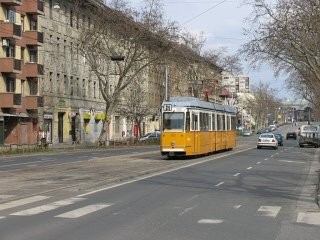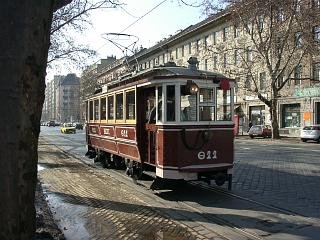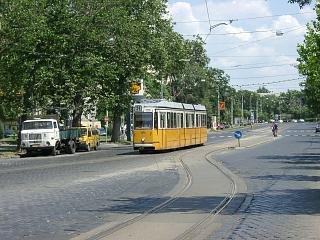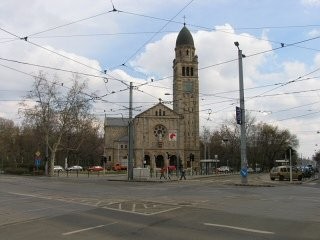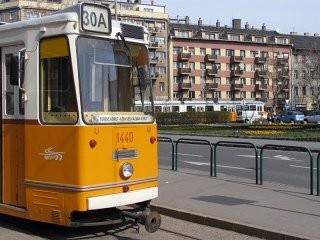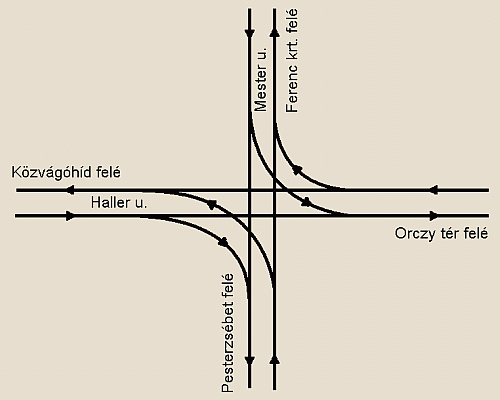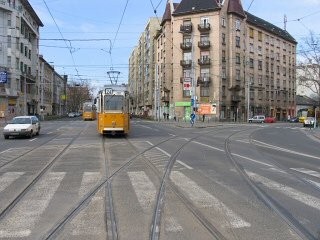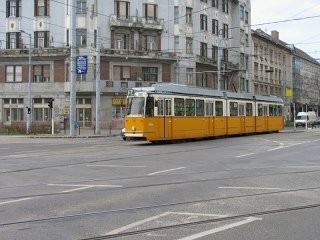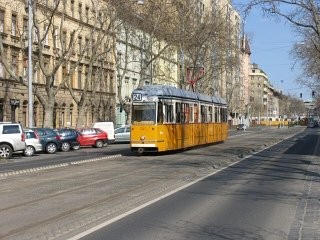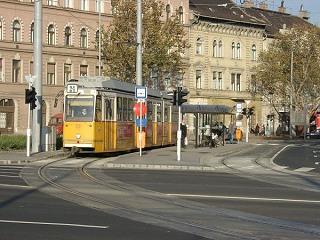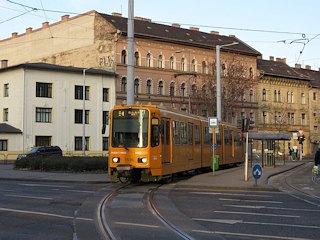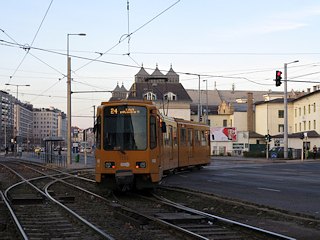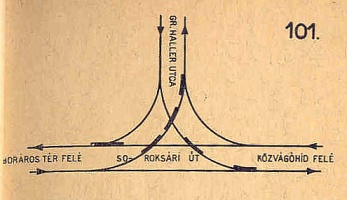Latest update: 5. January, 2016
Update, Januar 2016: This line has been operated with Ganz CSMG2 and KCSV7 cars for many years, but from January 1st it became partial TW6000 territory. On weekends you'll only see ex-Hannover LRVs here, on working days they're mixed with a few Ganz cars.
This line is often overseen by tram fans, and probably with a reason, because the vicinity where it runs is hardly a tourist's dream - for example you will often find poor, badly dressed, drunken or homeless people on the vehicles (I mean more often then elsewhere in Budapest). Nonetheless, some of the most interesting tram junctions/crossings can be found here, and if you're into depot rides, this line might be worth a visit around 9-10 AM or 4-5PM on working days. And even if you won't be riding route 24, this page might provide some interesting insights into Budapest's urban transit history...
This line basically crosses two poor quarters of Pest: Józsefváros ("Josefstadt" - named after Joseph Anton Johann (Baptist) von Österreich-Toscana, Regent of Hungary between 1796 and 1847) and Ferencváros ("Franzstadt" - named after austrian emperor and hungarian king Franz Joseph Karl von Habsburg-Lothringen). Sections of route 24 were first serviced by the horse tram: the stretch between Baross tér and Orczy tér were part of the BKVT line from Rákóczi út to Kőbánya (1868), while the section between Orczy tér and Nagyvárad tér was an extension of the trunk line in Üllői út (1869) - both were branch lines of the most important transportation corridors in Pest, now served by the M2 and M3 metro lines. The Üllői út line soon spawned another branch leading to Népliget via Elnök utca and Könyves Kálmán körút in a quite roundabout way, because the straight path via Üllői út belonged to another company (BLVV) between Nagyvárad tér and Népliget. 1904 saw yet another turnout, this time from Nagyvárad tér via Haller utca to Soroksári út, completing the route of today's tram line 24. Even so, line 24 itself was launched as late as 1951, between Baross tér and Boráros tér. Soon the service was extended on one end and shortened on the other, but those changes did not last for long. Today's route 24 was established in 1953.
Trivia: Interesting to note that the part of Józsefváros, where route 24 runs, was considered an unpleasant mess even ages ago - I've once read a newspaper article from 1863 in which they tried to find a solution for this problem. And somehow the problem lasted even through different political systems, although Józsefváros is now less bad than in the early 1990s, when it was known as the worst place in town - often referred to as "Bronx" or "the Ghetto".
"Monorail": Another probably interesting piece of trivia: the long-gone "suspended freight railroad" - an early kind of monorail - operated between today's Baross tér and Kőbánya in 1827-28. This railway used a system patented by englishman Henry Palmer, was constructed out of wood, with horses used to pull trains. Unfortunately the 7.6 kilometer long line did not work out, and was dismantled. Strange to imagine that this vicinity has had a monorail long before most other places! :)
Here's a Google
Maps overview of the route:
Nagyobb
térképre váltás
Route 24: Baross tér - Festetics György utca - Fiumei út - Orczy út - Haller utca - Soroksári út - Közvágóhíd 5 km
Vehicles: TW6000 and Ganz
CSMG2/KCSV7
Home depot: Ferencváros
Remark: As mentioned earlier, this route crosses some "skid row" places, were it might be unwise to show up in the late hours, or to show off with expensive photo equipment.
![]()
Baross tér (Festetics György utca)
The route starts in a side-street called Festetics György utca. Although Baross tér was always an important traffic junction - especially after Keleti pályaudvar (Budapest East Station - originally designated as Central Station) was opened in 1884 - this street first saw tram usage in 1911, by services of the company BVVV on their way to the other side of the square, Bethlen Gábor utca (the services of BKVT reached the square Keleti pályaudvar via Fiumei út). Later it became part of a reversing loop. Then trams vanished from here, and only returned in 1968.
Festetics György utca was connected to other tram lines in Baross tér - mainly Thököly út only after 1973 -, and so it remained until 2004/2005, when the whole of Baross tér was turned into a big contruction site for the M4 metro line. The terminus has a scissors crossover, but nowadays only one track is used by departing trams; the other is for storage/reserve. You can easily guess that this layout wasn't built for just one route: route 36 started from here until 1994, route 23 until 2000.
The run-down surroundings might not be appealing for tourists, but it seems to fit movie productions perfectly. On the images above we see on-site rehearsals for the Lajos Koltay movie "Fateless", but the street was also used for reproducing scenes of the 1956 revolution for the hungarian movie "Szabadság, szerelem" and the US television mini-series "The Company".
After a few hundred meters in Festetics György utca, the tracks take a turn into...
Here the tram has a private right-of-way.
Note the art nouveau style overhead supports - this design was once often used in Budapest, but you won't find it elsewhere anymore.
As we approach depot Baross, we arrive to a very interesting tram junction/crossing - it's probably the most interesting such facility in town. It's a remnant from the past - from times, when the tram was a much more important thing in the city's life:
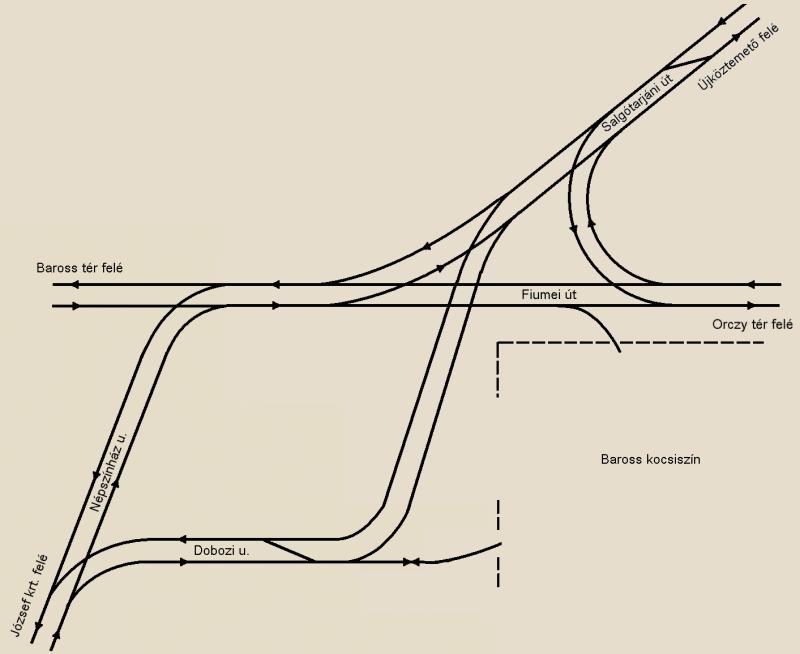
Map drawn by Mr. Balázs
Fejes, later modified by me
Route 28 and 37/37A both arrive from Népszínház utca (lower left corner on the map above), and part ways at the corner of a small park. Line 37/37A turns right, into Doboz utca, encircles the small park, and then turns left into Magdolna utca to reach Salgótarjáni utca. Line 24 arrives from Baross tér (left-hand side on the map), and goes straight to Orczy tér (right-hand side), being joined by line 28 at the upper left corner of the small park. The bend leading from Fiumei út to Salgótarjáni utca was once used by the exhibition line 29Y, and is sometimes still used by the cemetery line 37B, and depot/special rides. The bend from the other direction is used by depot rides and transports. On the map we can also see two entrances into the depot ("kocsiszín"): the one on top (from Fiumei út) is not used, while the other one (below, accessable from Dobozi utca) is probably used more often than the depot's main entrance.
To cut a long story short, this is very nice place for tram photographers, especially before and after the rush hours, when all kinds of depot rides (route 37 from/to Ferencváros, route 4/6 from/to Hungária, route 1/1A from/to Baross) are crossing the ways of scheduled trams!
Teleki László tér/Salgótarjáni utca
On our way from Baross tér to Közvágóhíd, we meet the turnout of tram 28 first.
-> Over to the joint inner section of route 28/37/37A
Coming from the other side of the small park is route 37/37A.
Salgótarjáni út can both be accessed by route 37/37A from this direction (used by a test run on the photo on the left), or via another pair of tracks branching off route 24/28 (used by a depot ride on the photo on the right). The first is the normal way, the other is only used rarely.
-> Forward via route 37/37A to Kozma utca/Új Köztemető
But we don't turn anywhere: we go straight, crossing the tracks of route 37/37A.
And we're now running along the walls of remise Baross.
To the left: here we will also find a third track, which is sometimes occupied by defective vehicles or special rides. To the right: the Orczy tér tram stop.
| A
lost railway station: Budapest-Józsefváros
This is also a kind of "lost rails of Budapest", but not in a tram, but in a "big" railroad way. If you take a look at the other side of the street, you will see a series of old buildings. This used to be Józsefvárosi pályaudvar - Budapest-Józsefváros railway station. The last train has left the station in December 2005, since then rails are rusting away without any actual usage. The station was built by a private railway company in 1867 for the Budapest-Hatvan-Salgótarján-Fülek (now Filekovo in Slovakia)-Losonc (now Lucenec, also in Slovakia) railroad, but the company went bankrupt soon after the line was complete. The state took over operation next year, thus the station - then called Losonci pályaudvar - became the first station of the company that later became MÁV, in Budapest! (This wasn't the first railroad Hungary, but those were all built, operated and owned by private companies, and not by the state.) Of course the station lost its importance as soon as Keleti pályaudvar was opened, so between 1885 and 1936 Józsefvárosi pályaudvar was only used as a goods station. In WW2 the place became the site of horror: many hungarian jews were put aboard the death trains heading for the nazi concentration camps here. It's almost unbelievable that the station is still there after such a surging history - it's now being converted into the "House of Fates", a museum about the Holocaust in Hungary. |
We're parting ways with route 28 here, as it turns into Kőbányai út (left), while we are heading for Orczy út (via the tracks on the right).
-> Forward via route 28 to Új Köztemető
This tram depot is the oldest electric tram depot still in use in Budapest: it was built in 1888-89. Its future is not certain: current plans for the rehabilitation of the area see it closed and knocked down.
To the left: Tatra sets in front of the main entrance of the depot. To the right: the remise has several small sheds instead of one large hall. Click here to see a track map of the remise, drawn by Mr. Balázs Fejes.
| Lost
rails: Baross utca
Baross utca (then called Stáció utca) has had the first normal-gauge electric tram line in Budapest (the first Grand Boulevard tram was meter-gauge), opened in 1889. The line was closed in 1953, but a few hundred meters of tracks remained in situ for storage of trams. |
To the left: the halfway-private (only used by trams and cars accessing the parking places on the right) right-of-way on the west side of the square. To the right: Orczy tér is also the terminus for trolley bus line 83 - and during the M4 construction works for line 89, which complements the former.
Now comes an unfriendly stretch with bomb-sites, houses falling apart, and a piece of what once was known as (Ganz-)MÁVAG.
The stop at Golgota tér/Vajda Péter utca.
The rest of Orczy út is a bit better: one side is occupied by smaller houses (left), the other also sports some high-rise blocks (right).
We soon arrive to Elnök utca/Diószeghy Sámuel utca.
| Lost
rails: Elnök utca
Elnök utca was the "race line" of BKVT, launched as the answer to the BVVV line in Vajda Péter utca. Both were leading to Népliget, but the latter proved more successful, so the first was abandoned after WW2. You won't find any traces of the tram anymore, but some trolley bus overhead wires are still hanging over the street. This wasn't part of a trolley bus line, but served for depot rides between the line 83 in Baross utca and line 75 in Népliget. Latter was replaced between Stadionok and Népliget by tram route 1/1A in 2000, but these wires somehow remained. |
After passing by an old factory building (left), we arrive to Nagyvárad tér, which sports the highest office building in Budapest, the SOTE tower, built in 1978 (88 meters high - we don't have skyscrapers in Budapest, most inhabitants are against them).
Hospitals are what you will find around Nagyvárad tér, some of which actually look more like a military depot. But this doesn't really matter to us, because it's hard to take good photos of the tram here because of the vehicular traffic :)
If you ask me, the stretch between the stops Balázs Béla utca and Mester utca is much more suited for taking photos!
Until 2002 this was the last strech in Budapest featuring the traditional streetside-running tracks. It was nice from the tram-freak-point-of-view, but the vicinity started to live again once the street was rebuilt in its whole width!
As mentioned earlier, you can also catch Combinos here heading for their home depot Hungária (left).
The small square with the church on one corner is where routes 24 and 51/51A (formerly called 21/21A, and three years earlier 30/30A) meet.
It's also where the depot runs of route 2/2A and 4/6 diverge from scheduled runs.
The remaining stretch can be very nicely photographed in the morning or the evening, ...
... while taking photos on winter afternoons might not be a very good idea because of the long shadows of nearby buildings :) The stop Soroksári út lays in the "firth" of Haller utca, and then tram 24 joins route 2 for about a kilometer before reaching the terminus Közvágóhíd.
-> Over to route 2 'till Közvágóhíd
![]()
Back to the
top
Back
to the opening page
Back
to the clickable map
Disclaimer: The author cannot
be held responsible for mistakes, misinterpretations, inaccuracies, inactualities,
etc. on/of these pages, nor for the content of other pages linked in.
Archive photos: from the
collections of Dr. Zoltán Ádám Németh and Zsolt Levente Nagy
Track layout drawings: BSzKRt
(collection of Dr. Zoltán Ádám Németh), Fejes Balázs
![]()
Send
a mail to the author
The
author's homepage
